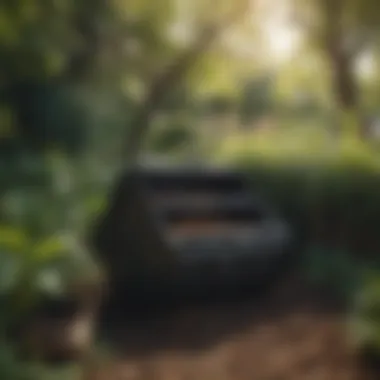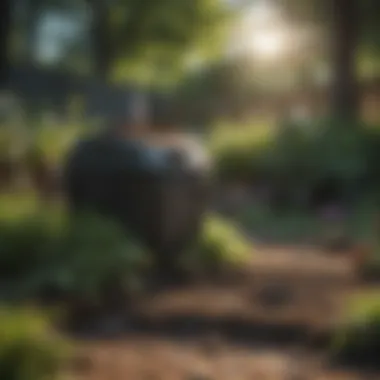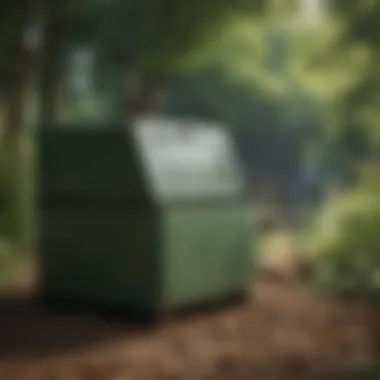Creating a Home Compost Bin: A Sustainable Guide for Eco-Friendly Living


Nature Topic Overview
Creating a home compost bin is a sustainable practice that promotes eco-friendly living. By repurposing organic waste into nutrient-rich compost, individuals can reduce waste and enrich their gardens with natural fertilizers. This comprehensive guide will walk you through the process of setting up and maintaining a home compost bin, offering practical tips for a greener lifestyle.
Fun Facts and Trivia
Did you know that composting at home can divert a significant amount of waste from landfills? In fact, composting kitchen scraps and yard waste can help reduce greenhouse gas emissions and contribute to a healthier environment. Encourage young readers to get involved in composting by showcasing how every small effort can make a big impact!
Wildlife Explorations
While composting directly involves organic materials, its impact extends to supporting various microorganisms and insects in the ecosystem. Earthworms, for instance, play a crucial role in breaking down organic matter in a compost pile. Explore the fascinating world of composting with interactive quizzes and activities that shed light on the diverse array of creatures that thrive in a composting habitat.
Environmental Awareness
Conservation and sustainability are at the heart of composting. Through composting, individuals can minimize waste, conserve resources, and promote a circular economy. Educate children on the importance of sustainable practices like composting and empower them with simple tips to contribute to nature conservation efforts at home.
DIY Nature Activities


Let's get hands-on with nature-inspired activities! From building a compost bin to exploring the science behind the decomposition process, there are plenty of engaging projects for kids to delve into. Step-by-step guides and suggestions for outdoor explorations will encourage young learners to connect with nature while learning about the benefits of composting.
Introduction
In this era of environmental consciousness, creating a home compost bin stands as a commendable step towards sustainable living. Embracing the art of composting not only benefits the environment but also nurtures a sense of responsibility within individuals. This comprehensive guide aims to enlighten readers on the intricacies of composting, from its humble beginnings to the bountiful outcomes it offers. By delving into the nuances of composting, individuals can significantly reduce their carbon footprint while enriching their gardens with nutrient-dense compost.
Understanding the Importance of Composting
Benefits of Composting
Composting offers a plethora of benefits that extend far beyond its surface-level advantages. Not only does it help reduce waste by transforming kitchen scraps and yard trimmings into valuable nutrients for the soil, but it also fosters a sustainable cycle of growth and decay. The key characteristic of composting lies in its ability to close the loop of the natural ecosystem, making it a popular choice for eco-conscious individuals. The unique feature of composting is its dual advantage of waste reduction and soil enrichment, making it a pivotal component of this sustainable guide.
Impact on Reducing Landfill Waste
The impact of composting on reducing landfill waste cannot be understated. By diverting organic matter from landfills, composting minimizes the production of harmful greenhouse gases, thereby mitigating the environmental burden. This eco-friendly practice not only reduces the strain on overflowing landfills but also aids in preserving the delicate balance of our natural surroundings. The distinctive feature of reducing landfill waste through composting holds immeasurable advantages for the environment, making it an indispensable aspect of this guide.
Setting the Foundation
Choosing a Suitable Location for the Compost Bin


Selecting an ideal location for the compost bin is paramount to its efficiency and effectiveness. The key characteristic of choosing a suitable spot lies in ensuring proper drainage and access to sunlight. This strategic decision not only accelerates the decomposition process but also prevents issues such as waterlogging. The unique feature of selecting the right location is its ability to optimize the composting environment, offering unparalleled advantages for the composting journey.
Selecting the Right Materials
The selection of appropriate materials serves as the building blocks of a successful composting endeavor. From green nitrogen-rich components to brown carbon-rich elements, each material plays a vital role in maintaining a balanced compost pile. The key characteristic of selecting the right materials lies in achieving a harmonious blend that promotes healthy decomposition. This crucial aspect of composting not only accelerates the process but also ensures the production of high-quality compost, emphasizing its significance in this sustainable guide.
Building the Compost Bin
DIY vs. Purchasing a Ready-Made Bin
The decision between DIY and purchasing a ready-made compost bin entails various considerations. While DIY bins offer a personalized touch and the satisfaction of creating a customized solution, ready-made bins provide convenience and ease of setup. The key characteristic of this decision lies in balancing one's preferences with practicality. The unique feature of this choice is its flexibility, allowing individuals to tailor their composting experience based on their needs and capabilities.
Step-by-Step Guide to Constructing a Compost Bin
Constructing a compost bin involves a systematic approach that ensures functionality and durability. From selecting the right materials to assembling the bin with precision, each step contributes to the overall success of the composting process. The key characteristic of this guide lies in its detailed instructions and visual aids, simplifying the construction for individuals of all skill levels. The unique feature of this guide is its comprehensive nature, offering a clear pathway to creating a sturdy and efficient compost bin.
Maintaining Your Compost
Turning the Compost


Regularly turning the compost is essential for aerating the pile and facilitating the breakdown of organic matter. The key characteristic of turning compost lies in promoting microbial activity and preventing anaerobic conditions. This beneficial practice ensures the even decomposition of materials, leading to the production of rich compost. The unique feature of turning compost is its role in maintaining a healthy compost pile, which translates into flourishing gardens and plant growth.
Managing Moisture Levels
Managing the moisture levels of the compost pile is crucial for optimizing decomposition rates and preventing unpleasant odors. The key characteristic of moisture management lies in achieving the perfect balance between dampness and dryness. This meticulous task ensures that beneficial microorganisms thrive while discouraging the proliferation of harmful bacteria. The unique feature of moisture management is its direct impact on compost quality, underscoring its significance in maintaining a fruitful composting process.
Utilizing Compost in Your Garden
Harvesting Mature Compost
Harvesting mature compost marks the culmination of the composting journey, resulting in a potent organic fertilizer for plants. The key characteristic of harvesting compost lies in recognizing its rich texture and earthy aroma, indicating readiness for use. This rewarding process offers a sense of fulfillment and tangible rewards for diligent composters. The unique feature of harvesting compost is its transformative nature, turning waste into valuable resources that nourish the soil and enhance plant growth.
Tips for Using Compost Effectively
Effectively utilizing compost in the garden requires a strategic approach that maximizes its benefits. From top dressing soil to creating compost tea, there are various techniques to incorporate compost into gardening practices. The key characteristic of using compost effectively lies in understanding its nutrient content and application methods. This knowledge empowers individuals to make the most of their compost, enhancing soil fertility and plant vitality. The unique feature of using compost effectively is its versatility, offering endless possibilities for sustainable garden management.
Troubleshooting Common Compost Issues
Identifying and Fixing Odors
Addressing odors emanating from the compost pile is essential for maintaining a pleasant composting experience. The key characteristic of dealing with odors lies in identifying the root cause, whether it be excess moisture, inadequate aeration, or improper ingredient ratios. By pinpointing the source of odors, individuals can take targeted actions to mitigate unpleasant smells and restore balance to the compost pile. The unique feature of odor management is its transformative effect on the composting process, ensuring a harmonious environment for healthy decomposition.
Dealing with Pests
Managing pests in the compost pile is crucial for safeguarding the integrity of the composting process. From ants to rodents, various pests may be attracted to the organic matter in the compost bin. The key characteristic of pest control lies in implementing preventive measures such as proper covering and turning of the pile. By addressing pest issues promptly, individuals can preserve the quality of their compost and prevent infestations. The unique feature of pest management is its role in upholding a hygienic and efficient composting system, fostering a productive environment for nutrient recycling.







